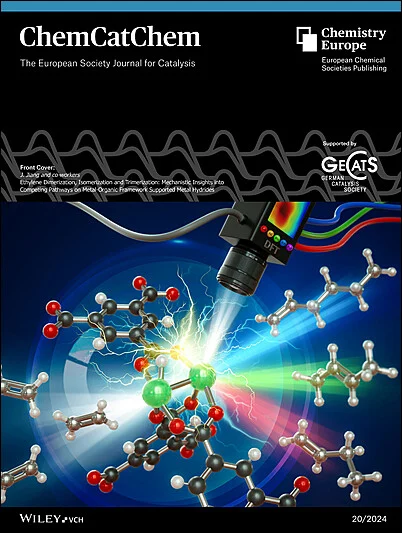Titanium Silicate-1 Coupled with Sn and Er as Effective Catalysts for the Production of Lactic Acid from Saccharides
IF 3.8
3区 化学
Q2 CHEMISTRY, PHYSICAL
引用次数: 0
Abstract
Biomass-based saccharide valorization to produce lactic acid (LaA) via chemocatalysis has emerged as a promising approach to meet the substantial demand of global LaA market, whereas the manufacture of prominent heterogeneous catalyst is still challenging. Herein, we fabricate a series of heterogeneous rare earth catalysts, and indicate that Er supported onto titanium silicate-1 (TS-1) exhibits better activity than other rare earth catalysts for glucose transformation towards LaA. Remarkably, coupling Sn with Er onto TS-1 enabled the sharp increment of LaA yield, and 3Sn15Er/TS-1 catalyst outperformed other heterogeneous rare earth catalysts as reported to date, giving as high as 82.2 % and 76.2% yields of LaA from sorbose and glucose, respectively. The catalyst characterization demonstrated the coexistence of Er2O3 and Sn2Er2O7 on 3Sn15Er/TS-1 catalyst, both of which contributed to LaA production. Sn doping favored the formation of active particles in smaller size and increased the Lewis acidic sites when compared to single 15Er/TS-1, thereby promoting the isomerization and retro-aldol reaction of glucose to C3 intermediates. 3Sn15Er/TS-1 catalyst also showed universal activity for diverse biomass-based saccharides. This work might give useful insights to explore heterogeneous rare earth catalysts with superior activity in biomass valorization.硅酸钛-1 与 Sn 和 Er 作为从蔗糖生产乳酸的有效催化剂
以生物质为基础,通过化学催化将糖转化为乳酸(LaA),已成为满足全球 LaA 市场巨大需求的一种前景广阔的方法,但制造杰出的异相催化剂仍具有挑战性。在本文中,我们制备了一系列异相稀土催化剂,结果表明,在葡萄糖转化为 LaA 的过程中,硅酸钛-1(TS-1)支撑的 Er 比其他稀土催化剂表现出更好的活性。值得注意的是,将 Sn 与 Er 耦合到 TS-1 上可使 LaA 产率大幅提高,3Sn15Er/TS-1 催化剂的性能优于迄今报道的其他异质稀土催化剂,从山梨糖和葡萄糖制得的 LaA 产率分别高达 82.2% 和 76.2%。催化剂表征结果表明,3Sn15Er/TS-1 催化剂上共存有 Er2O3 和 Sn2Er2O7,它们都有助于 LaA 的生成。与单一的 15Er/TS-1 相比,掺杂 Sn 有利于形成更小尺寸的活性颗粒,并增加了路易斯酸位点,从而促进了葡萄糖向 C3 中间体的异构化和逆醛化反应。3Sn15Er/TS-1 催化剂还显示出对多种生物质糖类的普遍活性。这项工作可能会为探索在生物质资源化方面具有卓越活性的异质稀土催化剂提供有益的启示。
本文章由计算机程序翻译,如有差异,请以英文原文为准。
求助全文
约1分钟内获得全文
求助全文
来源期刊

ChemCatChem
化学-物理化学
CiteScore
8.10
自引率
4.40%
发文量
511
审稿时长
1.3 months
期刊介绍:
With an impact factor of 4.495 (2018), ChemCatChem is one of the premier journals in the field of catalysis. The journal provides primary research papers and critical secondary information on heterogeneous, homogeneous and bio- and nanocatalysis. The journal is well placed to strengthen cross-communication within between these communities. Its authors and readers come from academia, the chemical industry, and government laboratories across the world. It is published on behalf of Chemistry Europe, an association of 16 European chemical societies, and is supported by the German Catalysis Society.
 求助内容:
求助内容: 应助结果提醒方式:
应助结果提醒方式:


